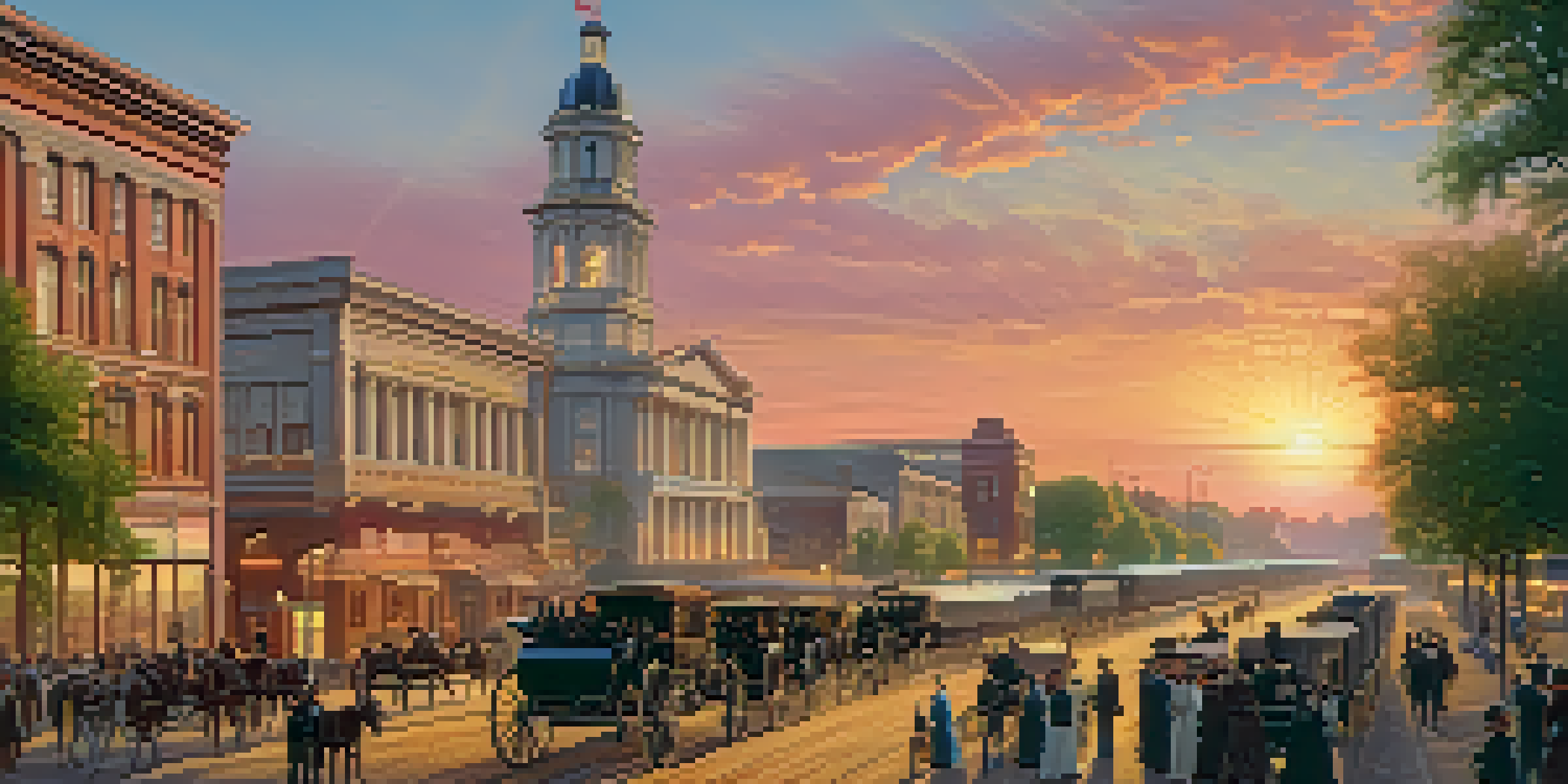The Impact of the Transcontinental Railroad on Sacramento

The Birth of the Transcontinental Railroad
The Transcontinental Railroad was a monumental project that connected the eastern U.S. to the West Coast. Completed in 1869, this railway transformed travel and trade across the nation. Sacramento, located at the heart of the Gold Rush, became a vital hub for this transportation network.
The railroads have been the greatest factor in the development of the West, bringing in settlers, resources, and new ideas.
As the western terminus of the railroad, Sacramento played a crucial role in facilitating the movement of goods and people. The railway enabled faster access to resources, further fueling California's booming economy. This shift marked the beginning of a new era for both the city and the state.
Moreover, the construction of the railroad brought thousands of workers to Sacramento. This influx of labor not only helped build the railway but also contributed to the city’s population growth, making it an essential center for commerce and culture.
Economic Growth and Prosperity
With the railroad in place, Sacramento's economy saw rapid expansion. Businesses flourished as products could now be shipped across the country in a matter of days. This newfound efficiency attracted entrepreneurs and investors eager to capitalize on the growing market.

The agricultural sector also benefited significantly, with farmers able to transport their crops to distant markets. Sacramento became known as the 'Farm-to-Fork Capital' as fresh produce reached consumers faster than ever before. This reinforced the city’s reputation as a vital agricultural hub.
Railroad Boosted Sacramento's Economy
The completion of the Transcontinental Railroad in 1869 spurred rapid economic growth in Sacramento, attracting businesses and enhancing trade.
Moreover, the railroad spurred the development of industries, including manufacturing and trade. The combination of transportation and economic opportunity created a thriving environment, attracting even more settlers looking for their piece of the American Dream.
Population Surge and Urban Development
As Sacramento became a key transportation hub, its population began to swell. The convenience of the railroad drew people from all walks of life, leading to a diverse community. This demographic shift played a significant role in shaping the city's cultural landscape.
The Transcontinental Railroad was a marvel of engineering that connected the nation and opened the door to a new era of economic growth.
The increase in population necessitated urban development, leading to the construction of homes, businesses, and infrastructure. Streets were paved, and public services were established to accommodate the growing needs of residents. Sacramento transformed from a small settlement into a bustling city.
Additionally, the diverse population contributed to a rich cultural mosaic. New communities brought their traditions, cuisines, and festivals, making Sacramento a vibrant place to live. This cultural blend has continued to influence the city’s identity to this day.
Transportation and Connectivity
The Transcontinental Railroad not only connected Sacramento to the eastern U.S. but also enhanced its internal transportation network. Local rail lines were developed, allowing easier access to nearby regions. This connectivity improved trade routes and travel options for residents.
As a result, Sacramento became a critical junction for freight and passenger trains alike. The ease of movement facilitated commerce and tourism, further boosting the local economy. Cities across California also benefitted as Sacramento emerged as a central hub.
Population Growth Transformed City
The influx of people drawn to Sacramento by the railroad led to significant urban development and a rich cultural landscape.
In essence, the railway transformed Sacramento into a gateway for exploration and economic opportunity. The improved transport options laid the groundwork for future development and growth, solidifying its importance in the region.
Cultural Exchange and Influence
The Transcontinental Railroad acted as a conduit for cultural exchange. As people from different regions traveled to Sacramento, they brought their customs and traditions with them. This blending of cultures enriched the city and fostered a spirit of inclusivity.
Festivals, art, and music from various communities began to intertwine, creating a vibrant cultural scene. Sacramento became known for its diverse offerings, from food festivals celebrating local cuisine to art galleries showcasing works from various backgrounds. This cultural melting pot remains a defining characteristic of the city.
Moreover, the railroad facilitated the sharing of ideas and innovations. The cross-pollination of thoughts and practices helped shape Sacramento's identity as a progressive city, open to new influences and opportunities.
Challenges and Consequences
While the railroad brought numerous benefits, it also introduced challenges for Sacramento. The rapid population growth led to overcrowding and strain on resources. City officials faced the daunting task of managing infrastructure and public services amidst the boom.
Additionally, environmental concerns arose as the urban landscape transformed. The expansion of railroads and industry impacted natural habitats, prompting discussions about sustainable development. Balancing growth with environmental stewardship became a pressing issue for the city.
Legacy of Connectivity and Culture
The Transcontinental Railroad's legacy is evident in Sacramento's continued role as a transportation hub and its vibrant, diverse community.
Furthermore, social tensions emerged as different communities navigated their place in the evolving city. Disparities in wealth and access to resources highlighted the need for equitable development, shaping policy discussions for years to come.
Legacy of the Transcontinental Railroad
The legacy of the Transcontinental Railroad continues to be felt in Sacramento today. Its impact on the city’s development is evident in the vibrant economy and diverse culture. The railroad laid the foundation for Sacramento's evolution into a modern metropolis.
Moreover, the history of the railroad serves as a reminder of the importance of connectivity and collaboration. Today, Sacramento remains a hub for transportation, with an extensive network of highways, railways, and air travel that fosters growth and opportunity.

As we reflect on the past, it’s clear that the Transcontinental Railroad not only transformed Sacramento but also shaped the identity of the American West. The stories of those who traveled and settled in this bustling city continue to inspire future generations.